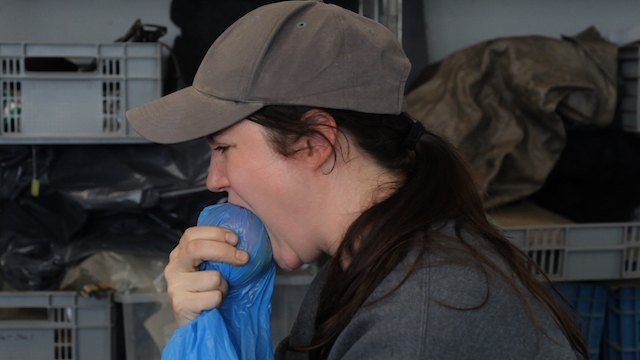I’ve always had a soft spot for the ‘history of everyday things’, to use French historian Daniel Roche’s phrase. To reconstruct the past lives of common objects is an act of invention as much as an archaeological process, a collaboration between the interpreter and the object in the production of a story. The power of Sofia Hultén’s most comprehensive exhibition to date derives from its persistent reimagination of the role of everyday stuff.
In contrast to other artists who work with found objects, the Swedish-born, Berlin-based Hultén isn’t content only to form new objects out of existing ones, attribute new functions to them or recontextualise them to imbue them with new meaning, though these are also characteristics of her work. The video Altered Fates (2013), which greets visitors at the cloakroom, sets the show’s tone and offers a key to understanding Hultén’s approach. We watch her pick out various discarded items from a large dumpster, intervening in some manner (cutting, adjusting, painting, nailing) and then returning them, repeating the process and varying only the mode of alteration. This reads at once as a manifesto and as an answer for which – as per the show’s title – we now must invent the question. Art is figured as a cyclical pursuit with no clear purpose, no end and no beginning: a process that preserves the artist’s mark, but for whom, for what? Evoking existentialist concerns with the absurd, this proposition about the nature of art is concerned with time, change and possibility. The playful title hinting at a preference for the fluidity of the unknown, rather than the perceived stability of being.
Immovable Object/Unstoppable Force (Skips) (2012) shows the artist in front of a dumpster – an emblematic object in her work – trying to use telekinesis to lift detritus from it, alas to no avail, opening up various interpretations and offering some comic relief. Several installations compel the viewer to reflect on mostly mass-produced and industrially fabricated materials and objects in their new composition, manipulated and transformed by the artist. See, among others, History in Imaginary Time (2012), grey hoodies painted with green stripes placed seemingly haphazardly on several freestanding fences, as if forgotten; Particle Boredom (2016–17), found particleboard reshaped and placed in space; Nu Cave (2011), a workshop shelving unit on which lie various objects, some connected to such an environment and others not, decayed by time and wear. But Hultén is strongest in her videos, performing these philosophical concepts in humorous and playful scenarios that disrupt expected narratives, sequences and patterns. In Nonsequences (2013), for example, wherein, in various orders, she wipes an apple on her trousers, throws it in the garbage, places it in a garbage bag and eats it, or Truckin’ (2015), in which she walks around the city putting on different shoes at different locations before continuing her walk.
The intended piéce de résistance, as promoted by the museum through its texts and layout, is Pattern Recognition (2017), a wall sculpture composed of groupings of sheeting used in workshops, on which hang tools and materials in varying arrangements. This work assembles the preoccupations visible in other works and combines them with the research of a Russian computer scientist, Mikhail Moiseevich Bongard (1924–1971), who developed diagrams used as benchmarks for determining the sophistication of artificial-intelligence machines in terms of their ability to recognise patterns. The title of Hultén’s exhibition here comes to fit even more tightly, as the patterns she creates on the wall ask to be decoded, and thus offer the viewer the possibility of formulating the questions: an action, ultimately, that lies at the core of what it means to be human.
Sofia Hultén: Here’s the Answer, What’s the Question? at Tinguely Museum, Basel, 24 January – 1 May
From the May 2018 issue of ArtReview
